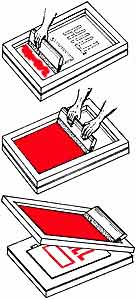
What is Serigraphy?
 Silk
screen, or serigraphy, is a stencil process. The printing element is a
rectangular frame, usually wood or metal, with a fine mesh screen stretched
across it. Originally the material used was silk, but newer synthetic
materials are now commonly used. When the stencil is affixed to the screen,
paint is poured into the hollow formed by the frame and scraped across
the surface, usually with a rubber squeegee. The paint is forced through
the open areas of the stencil and onto the paper. There are many kinds
of stencils, including a paint-resistant "glue" brushed directly
onto the screen and allowed to dry, hand-cut or photo-etched film which
is adhered to the screen with solvent or water, or even pieces of torn
or cut paper laid on the surface of the paper. Each
kind of stencil creates its own characteristic image, and the artist may
"mix and match" to achieve the desired effects.
Silk
screen, or serigraphy, is a stencil process. The printing element is a
rectangular frame, usually wood or metal, with a fine mesh screen stretched
across it. Originally the material used was silk, but newer synthetic
materials are now commonly used. When the stencil is affixed to the screen,
paint is poured into the hollow formed by the frame and scraped across
the surface, usually with a rubber squeegee. The paint is forced through
the open areas of the stencil and onto the paper. There are many kinds
of stencils, including a paint-resistant "glue" brushed directly
onto the screen and allowed to dry, hand-cut or photo-etched film which
is adhered to the screen with solvent or water, or even pieces of torn
or cut paper laid on the surface of the paper. Each
kind of stencil creates its own characteristic image, and the artist may
"mix and match" to achieve the desired effects.
Although stencil techniques are centuries old, silk screen was first introduced to modern art by Warhol, Indiana, Johns and others in the pop art movement. It was later used extensively by op and expressionist artists like Riley, Stella, Vasarely, Pollack, DeKooning and Motherwell. Today it is a decidedly mainstream print medium, used by such luminaries as McKnight, Max, Estes, Kelly, Katz, Sister Mary Corita (Kent) and many others.
What is an "Original Print"?
An "original print" is one created by hand by the artist in an edition of multiple pieces. Each print is usually similar to the others, although some artists (like Bob), because of their printing techniques, may cause visible differences among the individual prints. To the artists, differences created in this manner are intentional and desirable.
There may be as few as one, or as many as 50 individual colors in an original print. Each is hand numbered in a limited edition and usually signed by the artist. There is no one "original" art work from which the prints are reproduced - each print is created individually.
In contrast, many limited edition signed "prints" are actually photographic reproductions of an original painting, printed via commercial lithography in 4 colors, known as "process" colors, which give an approximate rendition of the original. Under a magnifying glass you can see the characteristic dot pattern of the colors, similar to comics or photos printed in magazines. These are truly reproductions, not original prints, and there is seldom any secondary market for this type of "print."